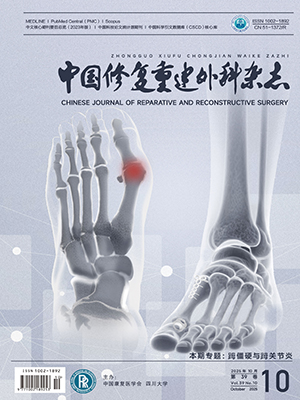| 1. |
Jiang X, Zhang H, Ren Y, et al. The pattern of collagen production may contribute to the gluteal muscle contracture pathogenic process. J Orthop Surg Res, 2023, 18(1): 579. doi: 10.3389/fcell.2020.00694.
|
| 2. |
Su Q, Zhang Y, Zhang Y, et al. Multivariate analysis of associations between patellofemoral instability and gluteal muscle contracture: A radiological analysis. J Pers Med, 2022, 12(2): 242. doi: 10.3390/jpm12020242.
|
| 3. |
Zhao W, Li Z, Ma S, et al. Identification of pro-fibrotic cellular subpopulations in fascia of gluteal muscle contracture using single-cell RNA sequencing. J Transl Med, 2025, 23(1): 192. doi: 10.1186/s12967-024-05889-y.
|
| 4. |
吴毅东, 于康康, 安明扬, 等. 平卧位关节镜下由内向外髂胫束松解术治疗双侧臀肌挛缩症的疗效观察. 中华医学杂志, 2023, 103(21): 1611-1616.
|
| 5. |
Hu J, Zhu J, Zhou Z, et al. Clinical outcomes of arthroscopic surgery in patients with gluteal muscle contracture: Single-institution results from a high-volume cohort. Med Sci Monit, 2024, 30: e942945. doi: 10.12659/MSM.942945.
|
| 6. |
余刚, 王明英, 赵其纯. 关节镜下 L 形松解治疗双侧臀肌挛缩症. 临床骨科杂志, 2022, 25(4): 502-506.
|
| 7. |
吴毅东, 于康康, 安明扬, 等. 对平卧位关节镜下由内向外松解骼胫束治疗双侧臀肌挛缩症的疗效观察. 骨科临床与研究杂志, 2022, 7(4): 198-202.
|
| 8. |
唐翔宇, 刘玉杰, 李春宝, 等. 臀肌挛缩症功能量化评分表的信效度检验. 中国矫形外科杂志, 2017, 25(4): 336-339.
|
| 9. |
Giai Via R, Elzeiny A, Pantè S, et al. Can we encourage the endoscopic treatment for external snapping hip (ESH)? A systematic review of current concepts. Eur J Orthop Surg Traumatol, 2024, 34(6): 2835-2844.
|
| 10. |
Zhang S, Dong C, Li Z, et al. Endoscopic iliotibial band release during hip arthroscopy for femoroacetabular impingement syndrome and external snapping hip had better patient-reported outcomes: A retrospective comparative study. Arthroscopy, 2021, 37(6): 1845-1852.
|
| 11. |
Jiang Y, Li T, Wang L, et al. Comparison of open surgery versus endoscopic-assisted release for gluteal muscle contracture: a systematic review and meta-analysis. J Orthop Surg Res, 2024, 19(1): 39. doi: 10.1186/s13018-023-04452-7.
|
| 12. |
Maldonado DR, Glein RM, Lee MS, et al. Patients with concomitant painful external snapping hip and femoroacetabular impingement syndromes reported complete snapping resolution with release of the gluteus maximus and iliotibial band, and comparable minimum 2-year outcomes to a propensity-matched control group. Arthroscopy, 2022, 38(6): 1890-1899.
|
| 13. |
刘玉杰, 王志刚, 李众利, 等. 臀肌挛缩的分型与关节镜微创治疗. 军医进修学院学报, 2010, 31(10): 947-948.
|
| 14. |
王浩, 刘诚, 郭孝军, 等. 关节镜治疗臀肌挛缩与开放手术疗效比较. 实用骨科杂志, 2022, 28(1): 73-76.
|
| 15. |
祝闽, 吴鹏, 朱佳壮, 等. 外侧型弹响髋不同治疗方式的临床研究. 实用骨科杂志, 2021, 27(8): 736-740.
|
| 16. |
张荐, 王斌, 赵洪波, 等. 类“Pie-crusting”辅助关节镜与开放手术治疗小儿Ⅲ度臀肌挛缩症疗效对比. 中国骨与关节杂志, 2025, 14(3): 228-232.
|
| 17. |
贺翔, 高嘉锴, 王陶然, 等. 创伤性臀肌挛缩症临床研究进展. 创伤与急危重病医学, 2024, 12(3): 186-190.
|
| 18. |
Browning RB, Fenn TW, Allahabadi S, et al. Open and endoscopic gluteus medius and/or minimus repair achieves clinical success regardless of tear grade: High-grade fatty infiltration portends worse outcomes. Arthroscopy, 2025, 41(4): 966-977.
|
| 19. |
Gao J, Chai N, Wang T, et al. A new technique of percutaneous minimally invasive surgery assisted by magnetic resonance neurography. Bone Jt Open, 2024, 5(9): 776-784.
|
| 20. |
Malinowski K, Mostowy M, Kim DW, et al. Gluteal complex is important in external snapping hip: intraoperative identification of syndrome origin and endoscopic stepwise release-a case series. Int Orthop, 2024, 48(2): 401-408.
|
| 21. |
Gao SG, Liu WJ, Yang M, et al. Clinical results of arthroscopic tight fibrous band release for adult moderate-to-severe gluteal fibrosis using anterior and posterior portals: a retrospective analysis of 118 consecutive cases. BMC Musculoskelet Disord, 2021, 22(1): 28. doi: 10.1186/s12891-020-03885-z.
|
| 22. |
Lim EJ, Kim JW, Doh CH, et al. Clinical outcomes following incomplete arthroscopic iliotibial band release for external snapping hip syndrome: An observational study. Orthop Surg, 2024, 16(5): 1153-1159.
|




